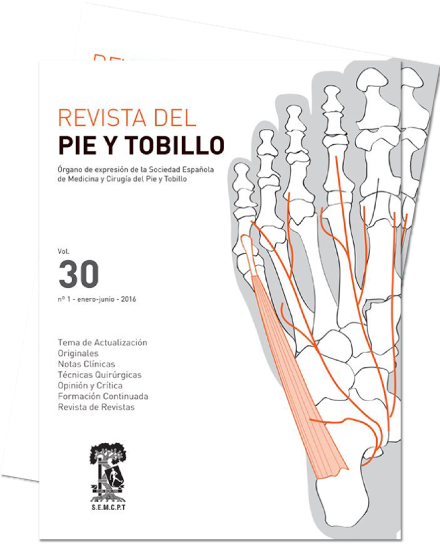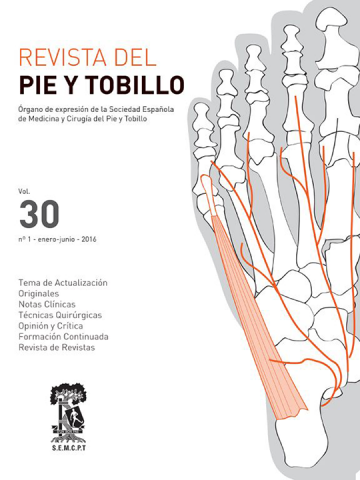Resumen:
Introducción
En el año 2009 publicamos un estudio con los resultados de la artrodesis metatarsofalángica mediante placa Fyxis® como tratamiento en los casos de hallux rigidus avanzado, evaluando la escala AOFAS con buenos resultados. En el 2011 se realizó una revisión manteniéndose los resultados. Aunque debatida, la tendencia en el postoperatorio es el uso de zapato de tacón invertido un mínimo de 8-10 semanas. Muchos de estos pacientes refieren incomodidad con este tipo de calzado, con trocanteritis, lumbalgias, inestabilidad e incluso caídas sobre todo los primeros días. A raíz de un paciente que no siguió nuestras recomendaciones y utilizó un zapato plano rígido sin complicaciones posteriores y tras un estudio biomecánico, nos preguntamos: ¿por qué no el zapato plano rígido?
Objetivo
Estudio prospectivo sobre el uso de zapato plano rígido en las artrodesis de la primera articulación metatarsofalángica, con un control histórico de pacientes intervenidos de la misma artrodesis entre los años 2006 y 2013 con zapato tacón invertido en el postoperatorio.
Material y método
Revisión de 67 artrodesis del primer radio entre 2006 y 2013 con zapato tacón invertido, evaluando parámetros clínicos y radiológicos pre y posquirúrgicos, grado de satisfacción y AOFAS. Estudio prospectivo de 16 pacientes, postoperatorio con zapato plano rígido, evaluando los mismos parámetros que en el grupo anterior. Análisis estadístico sistema SPSS mediante U de Mann-Whitney para variables no paramétricas y test de la chi al cuadrado.
Resultados
Los pacientes de ambos grupos presentan una mejoría de AOFAS pre y posquirúrgica (27 prequirúrgica, 87 postquirúrgica de media). Al compararlos, no encontramos diferencias estadísticamente significativas en cuanto a AOFAS posquirúrgica, funcionalidad ni grado de satisfacción. No diferencias estadísticamente significativas en cuanto a complicaciones; el 20% de complicaciones de la herida, 2 pacientes retraso de consolidación y ningún caso de fracaso de la osteosíntesis.
Conclusiones
Los pacientes con zapato plano rígido se muestran más satisfechos y presentan menos comorbilidad, sin ser estas diferencias estadísticamente significativas. Una vez comparados un grupo retrospectivo y uno prospectivo, el siguiente paso será diseñar un estudio prospectivo aleatorizado doble ciego para poder demostrar que siendo el zapato plano igual de efectivo que el tacón invertido su uso nos evita mayor morbilidad.
Abstract:
Introduction
In 2009 we published a study which showed results of the arthrodesis of the first metatarsophalangeal joint with Fyxis® plate in advanced hallux rigidus, evaluating the AOFAS scale with good results, and in 2011 a review was made, maintaining the same results. Although debated, the trend in the postoperative period is the use of high-heeled inverted shoe a minimum of 8-10 weeks. Many of these patients, refer discomfort with these shoes in the form of trochanteritis, back pain, unsteadiness and even falls especially the first day. After a patient who did not follow our recommendations and used a rigid flat shoe without further complications and after a biomechanical study, we asked ourselves; Why not use rigid flat shoe in the first metatarsophalangeal joint arthrodesis?
Objective
Prospective study about the use of the rigid flat shoe after arthrodesis of the first metatarsophalangeal joint, with a historical control group of patients who underwent the same arthrodesis between 2006-2013 with postoperative inverted heel shoe.
Material and method
Review of 67 first radius arthrodesis between 2006-2013 with inverted heel shoe, evaluating clinical and radiological parameters pre and post surgical, satisfaction and AOFAS. Comparing with a prospective study of 16 patients with postoperative rigid flat shoe, evaluating the same parameters. SPSS statistical analysis system using the Mann Whitney U for nonparametric variables and Chi-square.
Results
Patients in both groups showed an improvement in pre and postoperative AOFAS (27 preoperative - postoperative 87 on average). By comparison, we found no statistically significant differences in postoperative AOFAS, functionality or satisfaction. No statistically significant differences in complications; 20% wound complications, 2 patients delayed union and no cases of failure of fixation.
Conclusions
Patients with postoperative use of rigid flat shoe were more satisfied and had less comorbidity, without these differences being statistically significant. Once compared one retrospective group and one prospective, the next step is to design a double-blind randomized prospective study to demonstrate that the flat shoe is as effective as the inverted heel, but more comfortable.
Keywords:
Hallux rigidus
Arthrodesis
First metatarsophalangeal pain
Flat shoe
Inverted heel shoe





